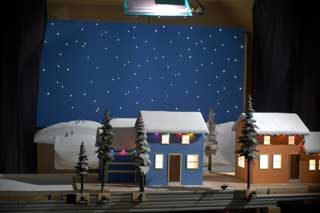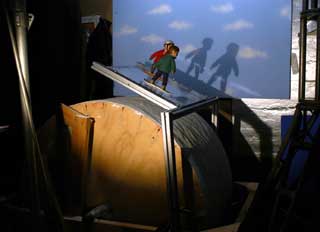It is easier for an animator to animate a fixed puppet on a fixed set or in a fixed vehicle and move the background and / or foreground to simulate driving, riding, snow boarding etc. Often our shots were long and required set pieces and trees to be recycled back through the shot as sections. (We didn't have enough room to dolly long sets through the shot.) You can do the math of how much set and speed you need. 60 MPH of full scale is 88 feet per second. At 1/10 scale that is about 9 feet per second screen time. At 30 MPH it would be about 4.5 feet per second. Also there is the factor of appearant speed that changes with camera angle. Check the ASC manual about this.

If you are trucking / moving parallel (not panning) with someone or a vehicle, the far distant background does not move in the frame. Objects and scenery in the mid ground have to move slower than objects in the foreground. We dollied houses, trees and snow set pieces behind puppets and vehicle windows to simulate trucking shots.
We built tracks to move the groups of trees on 4' bars and moved houses attached to 2' x2' plywood on a long table frame by frame. For night shots we recycled the trees and same houses with different light patterns to look different if the shot was very long. Each house was wired seperately with it's own interior and experior lighting.

Looking at The Frog and Toad animation we noticed a drum shot that looked promising for our down hill snow boarding. Ross and his crew build a drum out of 4' plywood disks and an aluminum skin. Ross textured it with snow with a slight pattern less than 1/4"above the surface. With edge light this was enough detail.
We used the drum for moving snow backgrounds behind our puppets when snow boarding. The drum though had limitations in perspective and size. The puppets were supported on glass slightly above the drum. Lighting was not easy to get the puppets to look like they were boarding on the drum and their shadows look right.
We shot each frame go-motion. Go motion is having something in the shot moving or the camera itself moving while the shutter of the camera is open. It gives a blured image as would film shot in real time would have and it enhanses the feeling of motion.
We had found that in Go Motion that you had to step back each frame and use part of the last background seen in the frame to keep a forward flowing feel. (Actually a backward flow of snow behind the puppet boarding downhill.) For stop motion you don't have to step back, but can continue stepping ahead. If you just stepped ahead, not including part of the last scene in go-motion the effect wouldn't flow forward but just pulsate. For example we would start the drum turning or table (described below) moving and then trip the camera. We then backed up part way so the next shot was partly contigious to the last frame. For the drum it was all done by hand.
Because of the size limitation of the drum we built a moving table of 3 pieces of 3' x 4' x 1/2" pieces of snow textured plywood with skate board wheels on each one. The joining pattern of 1 matched 2, 2 matched 3 and 3 matched 1 so that the pattern was continious as they were cycled through the shot. The sections were clamped together with kitchen door hardware. The moisture of the texturing warped the plywood, but the sections flattened out when the texture coat dried.
The sections were dollied on a 14 foot long pipe dolly track that allowed the middle and one end to be included in camera while the last section that had already moved by camera was recycled back to the beginning. The puppets were supported on glass with magnets.
Each table section was attached with a magnetic release base to a steel slider that was connected to the crank on the motor. To step the sections ahead the magnets were released. The magnets were left over from the Multipositional Magnetic Bases from Harbor Freight that we used for rigging and lighting mini hardware. The skate board wheels were at 45 degrees on one side but flat on the other because the tracks were not exactly parallel. This kept the wheels guided on one pipe while just riding on top of the other.
We made camera triggering more automatic. We moved the table sectionswith a crank on a 25 RPM motor that started at top dead center at 0 degrees and turned 180 degrees to a stop. (See Crank Dollies for description) Once the table was moving a microswitch then tripped the camera motor. The camera shutter was closed before the table stopped moving. Each take the table was stepped forward and the motor that moved the table section was cycled back to 0. This made the process much more consistant than done it by hand.
This effect could also be used to shoot a shot with a motion trail after moving object. The camera or object would stop at the end of a shot while the shutter is still open to give a sharp image with a blured trail behind it.
© Copyright 2004 Ron Dexter. All Rights Reserved.